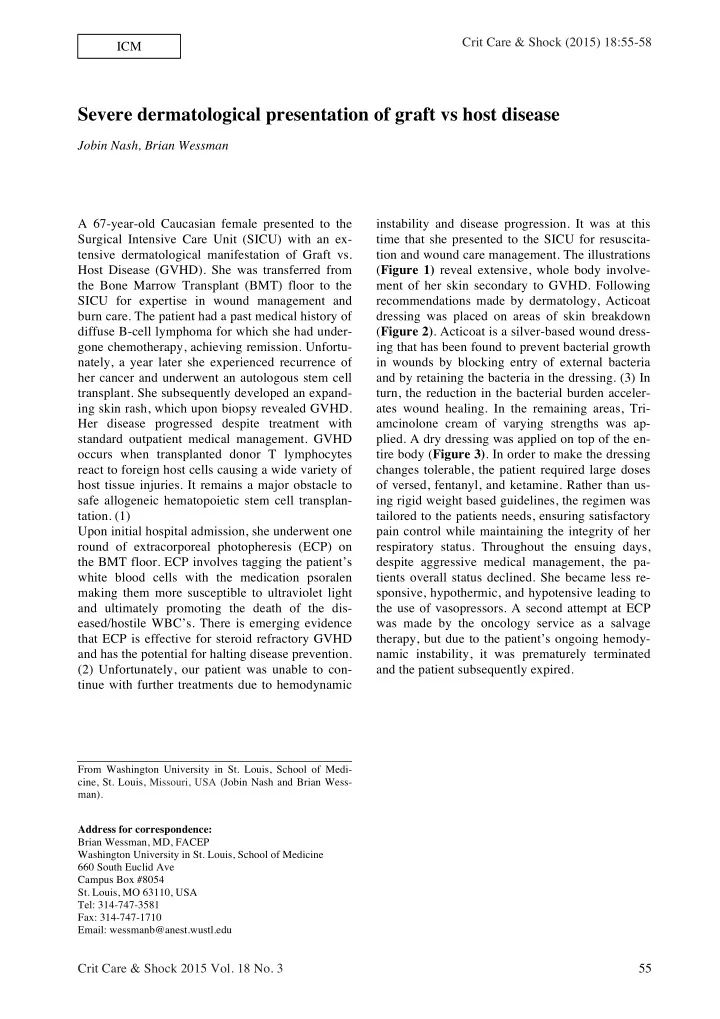

ICM Crit Care & Shock (2015) 18:55-58 Severe dermatological presentation of graft vs host disease Jobin Nash, Brian Wessman A 67-year-old Caucasian female presented to the instability and disease progression. It was at this Surgical Intensive Care Unit (SICU) with an ex- time that she presented to the SICU for resuscita- tensive dermatological manifestation of Graft vs. tion and wound care management. The illustrations Host Disease (GVHD). She was transferred from ( Figure 1) reveal extensive, whole body involve- the Bone Marrow Transplant (BMT) floor to the ment of her skin secondary to GVHD. Following SICU for expertise in wound management and recommendations made by dermatology, Acticoat burn care. The patient had a past medical history of dressing was placed on areas of skin breakdown diffuse B-cell lymphoma for which she had under- ( Figure 2) . Acticoat is a silver-based wound dress- gone chemotherapy, achieving remission. Unfortu- ing that has been found to prevent bacterial growth nately, a year later she experienced recurrence of in wounds by blocking entry of external bacteria her cancer and underwent an autologous stem cell and by retaining the bacteria in the dressing. (3) In transplant. She subsequently developed an expand- turn, the reduction in the bacterial burden acceler- ing skin rash, which upon biopsy revealed GVHD. ates wound healing. In the remaining areas, Tri- Her disease progressed despite treatment with amcinolone cream of varying strengths was ap- standard outpatient medical management. GVHD plied. A dry dressing was applied on top of the en- occurs when transplanted donor T lymphocytes tire body ( Figure 3) . In order to make the dressing react to foreign host cells causing a wide variety of changes tolerable, the patient required large doses host tissue injuries. It remains a major obstacle to of versed, fentanyl, and ketamine. Rather than us- safe allogeneic hematopoietic stem cell transplan- ing rigid weight based guidelines, the regimen was tation. (1) tailored to the patients needs, ensuring satisfactory Upon initial hospital admission, she underwent one pain control while maintaining the integrity of her round of extracorporeal photopheresis (ECP) on respiratory status. Throughout the ensuing days, the BMT floor. ECP involves tagging the patient’s despite aggressive medical management, the pa- white blood cells with the medication psoralen tients overall status declined. She became less re- making them more susceptible to ultraviolet light sponsive, hypothermic, and hypotensive leading to and ultimately promoting the death of the dis- the use of vasopressors. A second attempt at ECP eased/hostile WBC’s. There is emerging evidence was made by the oncology service as a salvage that ECP is effective for steroid refractory GVHD therapy, but due to the patient’s ongoing hemody- and has the potential for halting disease prevention. namic instability, it was prematurely terminated (2) Unfortunately, our patient was unable to con- and the patient subsequently expired. tinue with further treatments due to hemodynamic . From Washington University in St. Louis, School of Medi- cine, St. Louis, Missouri, USA (Jobin Nash and Brian Wess- man). Address for correspondence: Brian Wessman, MD, FACEP Washington University in St. Louis, School of Medicine 660 South Euclid Ave Campus Box #8054 St. Louis, MO 63110, USA Tel: 314-747-3581 Fax: 314-747-1710 Email: wessmanb@anest.wustl.edu Crit Care & Shock 2015 Vol. 18 No. 3 55
Figure 1 . Figure 2 . 56 Crit Care & Shock 2015 Vol. 18 No. 3
Figure 3 . Crit Care & Shock 2015 Vol. 18 No. 3 57
References 1. Goker H, Haznedaroglu IC, Chao NJ. Acute GVHD. Transfus Apher Sci 2015;52:151-6. 3. Lin YH, Hsu WS, Chung WY, Ko TH, Lin JH. graft-vs-host disease: pathobiology and man- agement. Exp Hematol 2001;29:259-77. Silver-based wound dressings reduce bacterial 2. Kitko CL, Levine JE. Extracorporeal photo- burden and promote wound healing. Int Wound J 2015 Jun 4 (Epub ahead of print). pheresis in prevention and treatment of acute . 58 Crit Care & Shock 2015 Vol. 18 No. 3
Recommend
More recommend